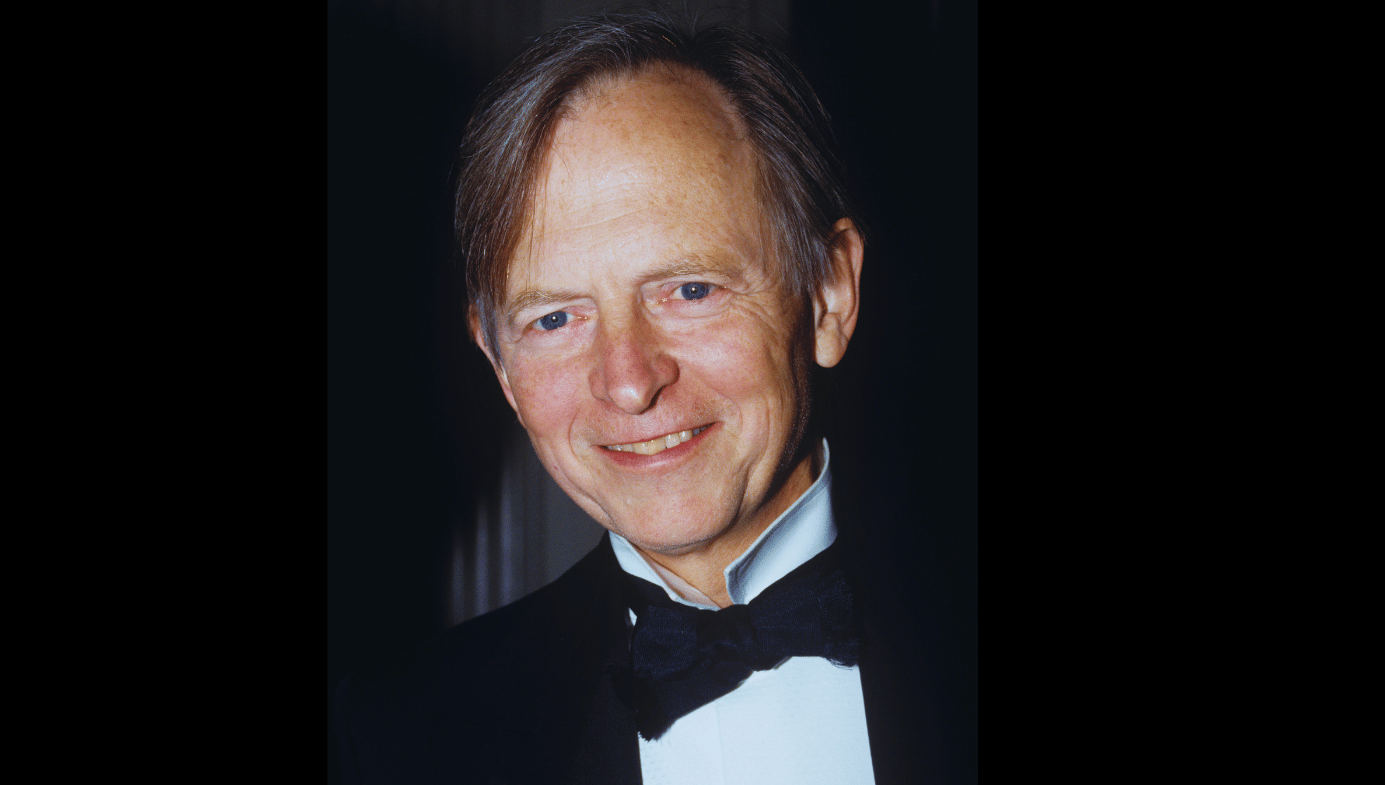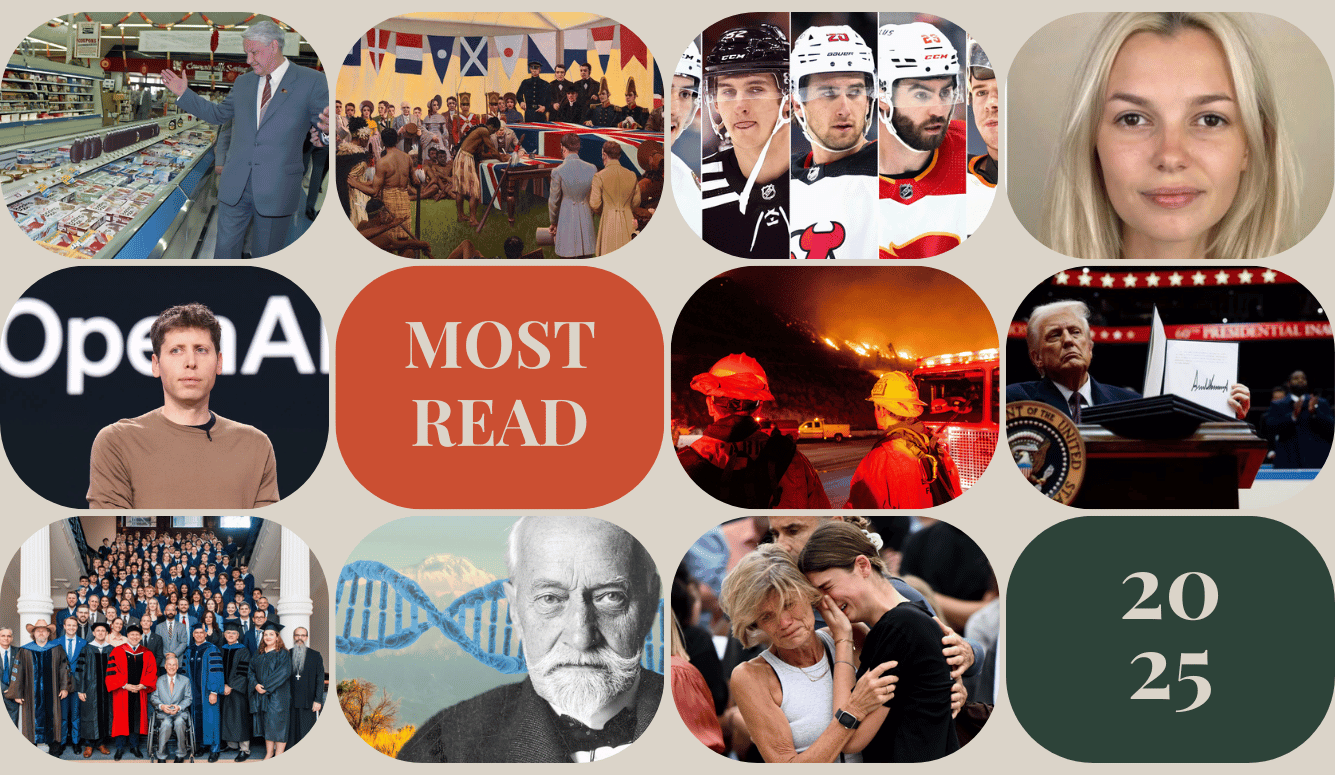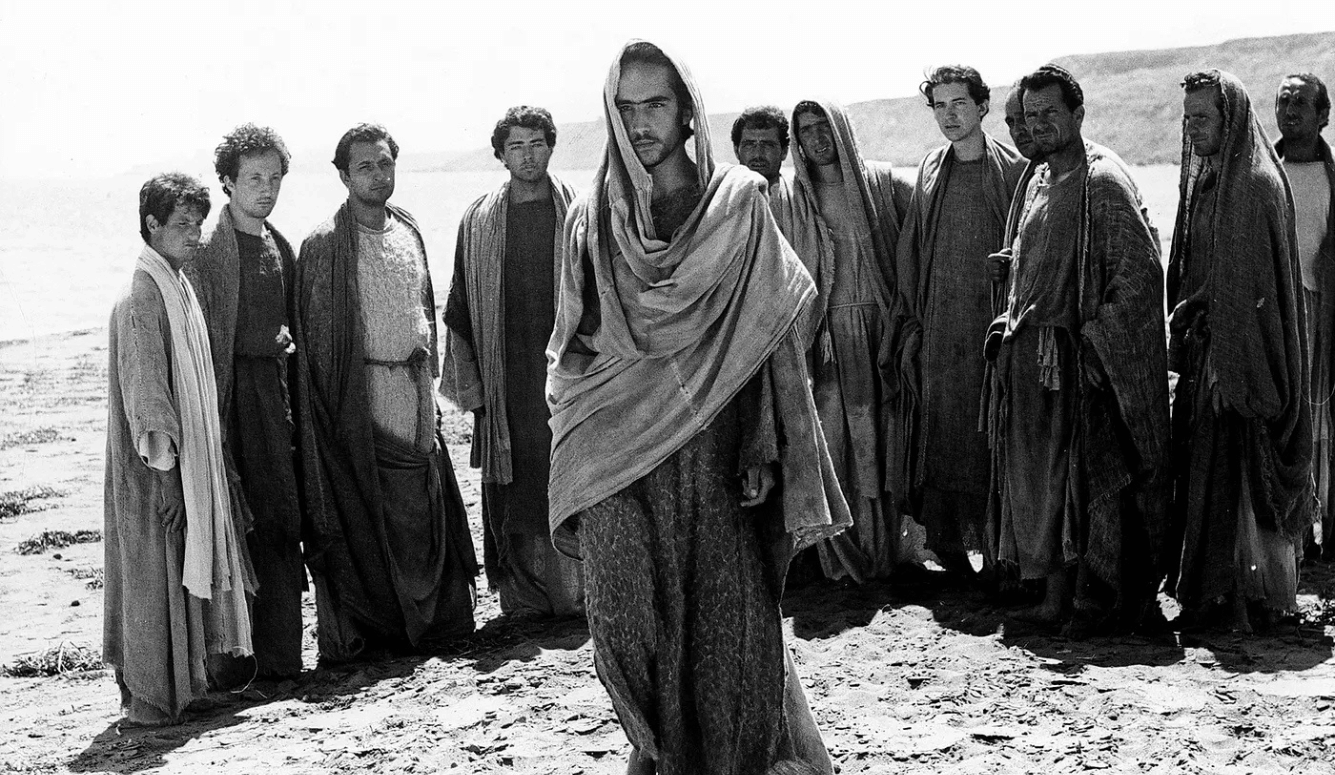Art and Culture
An Eye for the Jugular
A new documentary looks back on the life and work of satirist, novelist, and New Journalist, Tom Wolfe.

Directed by Richard Dewey, based on the Vanity Fair article by Michael Lewis, and enlivened by voiceover readings from the period-appropriate Jon Hamm, Radical Wolfe is a streamlined documentary biopic of Tom Wolfe, the most visible and verbose of the founding scriveners of the New Journalism. The film is the latest in a media-minded cycle of documentaries casting a wistful glance back at a bygone epoch, before the onset of digital communication, when print was ascendent, prose was read on paper, and the writer—not yet “content creator”—hunted-and-pecked out the words on an analog typewriter the size of a Frigidaire. The cohort includes Griffin Dunne’s portrait of his aunt, Joan Didion: The Center Will Not Hold (2017), Ebs Burnough’s The Capote Tapes (2019), and the best of the lot, Lizzie Gottlieb’s Turn Every Page: The Adventures of Robert Caro and Robert Gottlieb (2022). The last of these ends on a serendipitous cinema verité moment too good to be scripted: Caro and Gottlieb enter the offices of Alfred Knopf and need a pencil to copyedit Caro’s manuscript. “A pencil?” ask the befuddled Millennials.
The title of Radical Wolfe is a misdirection. It recalls the term “radical chic,” which would become one of Wolfe’s most famous contributions to the English language (others include: good old boy, this year’s girl, the Me decade, the Right Stuff, masters of the universe, etc.). Wolfe was, of course, not radical but retro, a Man of the Right, a dyed-in-the-wool (or white tweed to be precise) cultural conservative reared in the South and shaped by the Eisenhower era. His prose style rebelled against structure, grammar, and punctuation, but his affinities were pure Strunk and White.
Clocking in at a brisk 76 minutes, the documentary zips along like one of Wolfe’s mid-1960s Esquire profiles, when his exuberance was still constrained by page limits and word count. Dewey’s editing style seeks to evoke Wolfe’s fusillades of rapid-fire prose, the color scheme favors splashes of candy coloring and tangerine flaking, while the director’s approach to his subject is admiring and even hagiographic. “He helped to bring the new world into being,” gushes writer and actor Tom Junot, showing a flair for hyperbole that might have made even Wolfe blush.
Born in 1930 in Richmond, VA, to solidly middle-class but hardly patrician parents, Wolfe is nonetheless cast in the film as a scion of the old Confederacy. More than one of the friends interviewed describes him as a Southern gentleman of the old school. In another age, presumably, you might have found him sipping mint juleps on a plantation porch, with all that the image implies. Would he have observed the status distinctions between the field and the house slaves? Or only the belles and swains at the grand balls?
In 1952, Wolfe headed north to Yale University where he endured his first exposure to elite condescension, upper-crust privilege, and postvocalic Rs, a matriculation that nurtured what Niall Ferguson calls a lifelong vendetta against the intellectual Left. In 1956, he earned a Ph.D. in American studies with a dissertation entitled “The League of American Writers: Communist Organizational Activity among American Writers 1929–1942,” which, contrary to academic fashion even then, was not sympathetic to the communists.
Ever after, Wolfe’s ethnographies of the tribal rituals of his fellow Americans would be informed by a deep background in the Americanist canon of Henry Nash Smith, Perry Miller, and F.O. Matthiessen. (To dub “the Me decade” as the Third Great Awakening requires a familiarity with the previous two.) Taking his cue from Walt Whitman’s Democratic Vistas (“current and novel, the grandest events and revolutions, and stormiest passions of history, are crossing today with unparallel’d rapidity and magnificence...”), Wolfe embraced multitudes (grease monkeys, acidheads, fighter jocks) and kept his antenna tuned to the patois of his subjects. He also had a tendency to run off at the mouth.
After surviving Yale, Wolfe served an apprenticeship in the trade he was to blast to pieces: the pyramid-style structure and objective voice of traditional ink-stained journalism. Dewey includes an instructive vignette about Wolfe when he was still practicing the Old Journalism. As a beat reporter on the Springfield Union, he had a tense encounter with the young Sen. John F. Kennedy, who insisted that comments made in a roomful of Springfield businessmen were off the record. Wolfe disagreed and the piece was published; JFK tried to get him fired. A dramatic photograph preserves the face-off between the journalist and the politician, both men looking impossibly young.
In 1962, while working for the New York Herald Tribune, Wolfe needed an infusion of cash due to the New York newspaper strike. He pitched an article on the stock-car culture of Southern California to Esquire and editor Byron Dobel bites. (Today’s freelancers will listen slack-jawed upon learning of the deep pockets and casual largess of a slick monthly magazine back in the day, when assignment editors would not blink at footing the bill for a round-trip plane fare from New York to LA and four weeks at the Beverly Wilshire Hotel, including room service.)
The oft-told origin story of Wolfe’s accidental invention of his brand of New Journalism unfolds as another kind of Great Awakening. Under deadline pressure, and with the centerfold color layout already printed for the upcoming issue of Esquire, Wolfe was seriously blocked. In desperation, he began to speed-type his notes to editor Dobel, writing in stream-of-consciousness style. Dobel removed the “Dear Byron” salutation and published the piece as it was, under the onomatopoetic title, “There Goes (Varoom! Varoom!) That Kandy-Kolored (Thphhhhhh!) Tangerine-Flake Streamline Baby (Rahghhh!) Around the Bend (Brummmmmmmmmmmmmmm)…" When it appeared in Esquire in November 1963 under the byline Thomas K. Wolfe, the piece was a sensation.
The fuel-injected legend of Tom Wolfe took off like a rocket. A theorist as well as a practitioner of the genre, Wolfe gloated that, within the next few years, the New Journalism had upended the novel as the central event in American literature. In The New Journalism, the influential anthology he edited with E.W. Johnson in 1973, Wolfe argued that the novel had only itself to blame. By going highbrow, academic, and experimental, it abandoned the rich source material that had always been its lifeblood—manners and morals, class distinctions, status, and lingo; in sum, “the way we live now” as practiced by Austen, Thackeray, Dickens, and Trollop. “I’m just the stenographer,” Wolfe would say disingenuously, as if he were only taking dictation at the disco. He cultivated an especially keen eye for how clothes make the man and woman (the guy could write a chapter on the footwear of NYC cops).
Working along parallel lines in the new writer’s trade, and accorded prime placement in his anthology, were the likes of Jimmy Breslin, Truman Capote, Joan Didion, Hunter S. Thompson, and Gay Talese, whom Wolfe called his “conferees.” Not all of them were flattered to be drafted into the ranks. “You worthless scumsucking bastard,” wrote Wolfe’s frenemy Hunter S. Thompson. “I’ll have your goddamn femurs ground into bone splinters if you even mention my name again in connection with that horrible ‘new journalism’ shuck you’re promoting.”
A core tenet of the New Journalism playbook was to immerse oneself in the material at hand. “If you want to be a writer, you gotta stand in the middle of the traffic to see how fast the train goes,” Wolfe said. Writing about the Hell’s Angels? Ride with them. Reporting on the sexual revolution? Work at a massage parlor. Yet the participant-observer ethos of the New Journalism went only so far with Wolfe. To tune in, he did not have to turn on. Wolfe says he dropped LSD for his first single-topic bestseller, The Electric Kool-Aid Acid Test (1968), but only after getting off the Merry Prankster bus. “I found out the LSD experience is not a light show,” he remarked ruefully, thereby proving he imbibed.
Besides, Wolfe must have found it hard to fit in at the be-in in his work clothes. No documentary on Tom Wolfe would be true to its subject if it did not spend time caressing his threads—the tailored white suit that fit his tall, lean frame like a mauve glove. Before going out to hammer the supervillains of the Upper West Side, he suited up like an avenger in the Marvel Cinematic Universe.
Wolfe’s eye for fashion was matched by his eye for the jugular, and no one was cut deeper than the composer Leonard Bernstein, who with his wife Felicia (she of the “perfect Mary Astor voice”), hosted a fundraising party for the Black Panthers at their tony Park Avenue duplex in 1970. Wolfe weaseled his way into the party, and in the pages of New York magazine, executed a surgical evisceration of the hosts and the guests. Jon Hamm’s performative high point comes as he savors Wolfe’s succulent descriptions of the scene—the Panthers, the poseurs, and especially the hors d’oeuvres, those delectable “little Roquefort cheese morsels rolled in crushed nuts.”
For balance, the film interviews Columbia University professor Jamal Joseph, who was then cooling his heels in jail awaiting trial as one of the Panther 21 defendants. Having been bailed out with the money raised at the Bernstein soiree, he laments the fallout from the piece: the funding dried up. For the Bernstein family, decades later, the wounds are still raw. Wolfe was unmoved. “If you start worrying about [the effects on people], you’re no longer writing, you’re involved in public relations,” he said.
In 1979, Wolfe published The Right Stuff, a hero-worshipping account of the American space program that presaged the morning-in-America rebirth of the Reagan Revolution. It was really two books: the first, about the daredevil test pilots breaking the sound barrier and slipping the surly bonds of earth in the early, often lethal days of jet propulsion (its most memorable character was Chuck Yeager, whose laconic true grit embodied the title); and the second, about the seven original Mercury astronauts, who seem like buttoned down corporation men by comparison. In tandem with Phil Kaufman’s brilliant motion-picture adaptation in 1983, the book brought a dictionary’s worth of flyboy vernacular into the language: spam in the can, push the envelope, and light this candle. At the time, pundits said the film would boost the presidential prospects of Sen. John Glenn, but everybody who saw it wanted to vote for Chuck Yeager.
By then, Wolfe was as famous as any writer in America. Dewey unspools a blizzard of Wolfe appearances on talk shows and news magazines—Cavett, Letterman, 60 Minutes—to give a sense of the magnitude of the celebrity. “The author is in fact a bigger event than the book,” says Bryant Gumble, holding up a jacket cover with the byline in larger type than the title. Wolfe was also awarded the most coveted certification of status in American culture, a cartoon cameo on The Simpsons: Tom Wolfe “uses more exclamation points than any other major American writer!” gushes Lisa.
After The Right Stuff, Wolfe decided on a truly gutsy literary makeover: to invade enemy territory with “a Vanity Fair book about New York,” as he confided to an interviewer, who probably thought he was talking about the magazine. The result was The Bonfire of the Vanities, published in 1987, a work “taking journalism and torquing it back into fiction,” as writer and editor Terry McDonnell nicely puts it. The plot concerns a Wall Street bond trader who collides with the opposite end of the social-economic scale in the Bronx, but the story is really about race, class, media, and law with Wolfe’s nerve endings, as ever, “on red alert to the most intimate nuances of status.”
Ironically, or not, the film version of The Bonfire of the Vanities, directed by Brian de Palma in 1990, lived up to the title. An epic Hollywood boondoggle, it is best remembered today for having inspired one of the great behind-the-scenes books on the motion picture industry, Julie Salamon’s The Devil’s Candy: The Bonfire of the Vanities Goes to Hollywood, published in 1991, and later re-subtitled Anatomy of a Hollywood Fiasco. “What the hell happened with Bonfire of the Vanities?” Charlie Rose asked de Palma, who sheepishly admitted that he violated the text of the book. De Palma does not say how, nor is Salamon interviewed to enlighten us, but some of the book’s characters were badly miscast: Morgan Freeman was cast as the Jewish judge from the Bronx, a failure of nerve that neutered the fraught racial and class dynamics at the heart of the book. (Salamon tells the full story on TCM’s The Plot Thickens podcast.)

When Wolfe repeated his blockbuster success with A Man in Full in 1998, the for-real novelists—John Updike, Norman Mailer, and especially John Irving—were waiting with guns cocked to unload on the pretender. Reading any sentence of Wolfe, sneered a bitchy Irving, “would make me gag. If I were teaching fucking freshman English, I couldn’t read that sentence and not just carve it all up.” Irving and his conferees must have seethed as Americans ate it all up: the book’s first print run was 1.2 million copies—in hardcover.
Throughout Radical Wolfe, Wolfe’s private life is barely touched. His wife, graphic designer Sheila Berger, is described as “the perfect wife,” but her voice, Mary Astor or not, is not heard. His daughter Alexandra Wolfe speaks fondly of a father she gradually realizes is not like other Dads. Of all the peers from the glory days of the New Journalism in the 1960s, only Gay Talese is still around to comment, affectionately, on his friend and rival. Literary agent Lynn Nesbit and Vanity Fair editor Gail Sheehy attest to Wolfe’s personal kindness, but Talese understates, “he made enemies.” “The private man is an enigma,” remarks Michael Lewis, and Dewey leaves it at that.
Wolfe was so prolific that fans may kvetch about the work the film passes over. The mere title of his 1970 essay on the Office of Economic Opportunity in San Francisco, “Mau Mauing the Flak Catchers,” includes a verb so cancellable that it was evoked only in whispers during the BLM shakedowns of 2020. “The Intelligent Co-Ed’s Guide to America” published by Harper’s in 1976, was a prescient rumination on the insular groupthink on American college campuses where undergraduates “get the student-activity card and the map of the campus, and just about as automatically they get a packet of political and cultural attitudes.”
In 1996, in New York, Wolfe underwent quintuple bypass surgery. “I’m so mortal it’s not funny anymore,” he quipped, but he sank into a deep and long depression. Eventually, he rallied, with increasingly curmudgeonly essays and two long novels, I Am Charlotte Simmons (2004), about the latest sexual revolutions on campus, and Back to Blood (2012), about immigration. Neither was a capital-letter Must Read literary event, but perhaps by then, no book could be. Something else had displaced print as the central platform in American culture.
Wolfe died in 2018: a poignant coda shows NASCAR racer Junior Johnson, the subject of one of Wolfe’s most memorable Esquire profiles (“The Last American Hero Is Junior Johnson. Yes!” in 1965), turning up at Wolfe’s door for a last lap around the track. Wolfe’s once ramrod straight figure is now hobbled with curvature of the spine. “I’m still vertical,” Wolfe jokes to his guest.
Reflecting on the career of Ernest Hemingway in 1948, the poet Archibald MacLeish wrote that “fame became of him”; the public persona ended up swallowing the private artist. It was a fate that Wolfe—unlike his conferees Hunter Thompson and Truman Capote—avoided. He kept working, nose to the keyboard, until the end. “The human comedy has never been richer,” he was fond of saying. Maybe a little less so now that Tom Wolfe isn’t around to write about it.






